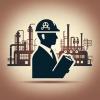HI EVERYBODY,
CAN ANYBODY SHARE THE WORK PROFILE OF A PROCESS ENGINEER AT A PETROLEUM REFINERY IN PROJECT PHASE.
THANKS IN ADVANCE
|
|

Process Engineer At Refinery Project
Started by Santhosh Kumar_205746, Sep 22 2012 01:37 AM
work profile
2 replies to this topic
Share this topic:
#1

Posted 22 September 2012 - 01:37 AM
#2

Posted 02 October 2012 - 11:46 AM
Hi Santhosh Kumar.
Next, I think that the following text clarify your spectations about Process Engineer.
Process Engineering
Process Engineering can also be called Chemical Engineering since it utilizes the basic chemical engineering fundamentals of:
One additional fundamental should be the “Judgment Balance”, since none of the other engineering disciplines make so much use of empiricism and trial and error methods. Many of process calculations are not completely rigorous, such as fractionator sizing, and judgment must be applied to the final answer.
Process engineering also makes use of most of the standard chemical engineering Unit Operations such as:
The process engineer works with the Development engineers in the early phase of his work and then he works closely with the Project Engineers after his specifications are completed in order to develop the complete Project Specification of the plant.
Some tips to consider
Engineering: Is the art and science by which the properties of matter and sources of power in nature are useful to man. The art is a skill, acquired by performance and experience, of knowing when to apply science and when to use empiricism to the tasks at hand.
Basic Fundamentals of Design
I Hope this will be useful for your profesiona life.
Next, I think that the following text clarify your spectations about Process Engineer.
Process Engineering
Process Engineering can also be called Chemical Engineering since it utilizes the basic chemical engineering fundamentals of:
- Equilibrium
- Thermodynamics
- Mass and energy transfer
- Material balance and energy balance
- Economic balance
One additional fundamental should be the “Judgment Balance”, since none of the other engineering disciplines make so much use of empiricism and trial and error methods. Many of process calculations are not completely rigorous, such as fractionator sizing, and judgment must be applied to the final answer.
Process engineering also makes use of most of the standard chemical engineering Unit Operations such as:
- Fluid flow
- Heat transfer
- Distillation
- Evaporation
- Absorption and Adsorption
- Extraction
- Drying
- Filtration
- Oxidation
- Reduction,
- Combustion
- Hydrogenation and Dehydrogenation
- Isomerization, Alkylation and Dealkylation
- Hydrolysis, etc.
- Establish the design basis
- Develop schematic flow diagram
- Develop mass balance
- Use V/L equilibrium for phase conditions
- Make recycle calculations
- Make fractionation equilibrium
- Develop energy balance
- Determine fractionator, and extractor internal loadings and the size of the vessels.
- Develop a comprehensive process flow diagram and controls.
- Issue the process design to project engineering.
The process engineer works with the Development engineers in the early phase of his work and then he works closely with the Project Engineers after his specifications are completed in order to develop the complete Project Specification of the plant.
Some tips to consider
Engineering: Is the art and science by which the properties of matter and sources of power in nature are useful to man. The art is a skill, acquired by performance and experience, of knowing when to apply science and when to use empiricism to the tasks at hand.
Basic Fundamentals of Design
- Calculable
- Material balance
- Energy balance
- Heat and mass transfer
- Equilibrium
- Variable
- Economic
- Operational
- Safety
- Environmental
- Judgment
- Process Concerns
- Establish basis of design
- Develop schematic flow
- Develop mass balance
- Calculate vapor/liquid (V/L) phase conditions
- Calculate mass transfer devices
- Develop energy balance
- Calculate vessel V/L loadings
- Develop process flow diagram
- Equipment Definition Concerns
- Establish unit hydraulics
- Establish metallurgy
- Define mechanical equipment
- Heat exchangers
- Rotating equipment
- Vessels/piping
- Instruments
- Construct piping and instrument diagram (P&ID)
- Reference use of standard specifications & drawings
- Prepare cost estimate
- Basic Engineering Design Data
- Process Information
- Mol balance
- Heat and weight balance
- Process flow diagram
- General equipment summaries
- Project Specifications
- Specific equipment specifications
- Metallurgy for equipment and piping
- P&I diagram
- Standard specifications and drawings
- API Technical Data Book, ASTM, ASME, NACE, Standard of Engineering.
- Bibliography and technical publications like specialized Textbooks on “Fluid mechanics” Victor L. Streeter, “Heat transfer” Donald Q. Kern, Chemical reaction O. Levenspiel, Oil Refining, Hydrocarbon Processing Magazine, Chemical Engineering Magazine, etc.
- NGPA Data Book.
- Perry’s Chemical Engineer’s Handbook, etc.
- Process Simulation packages. (Use, application and understanding the underlying theoretical aspects of simulation calculations)
- Engineering Calculations
- Excel Spreadsheets (advanced and VBA programming will be better)
- Dynamic Simulation (assessment)
- Engineering Database (use)
- Feed
- Quantity
- Properties
- Products
- Distribution
- Yields
- Properties
- Utilities (Quantity & Properties)
- Steam
- Water
- Fuel
- Power
- Bases/Goals for the project
- Economic
- Operational
- Environmental
- Standards/Codes
- Equipment details
- Safety
I Hope this will be useful for your profesiona life.
Edited by Profe, 02 October 2012 - 11:52 AM.
#3

Posted 03 October 2012 - 10:53 PM
Thank you very much sir, for your detailed explanation.
Surely it will be helpful for me.
Surely it will be helpful for me.
Similar Topics
Refinery Lpg Deethanizer Column DesignStarted by Guest_Ilyes_* , 15 Feb 2025 |
|

|
||
Going Through The Writing Process.Started by Guest_Haywardvek_* , 05 Jan 2025 |
|

|
||
Typical Process Of Platformate Splitter ?Started by Guest_AnbIran_* , 30 Dec 2024 |
|

|
||
Opportunities For Heat Recovery In A Chemical Process PlantStarted by Guest_tanyongboon1_* , 29 Nov 2024 |
|

|
||
Process Gas Compressor - Capacity Control ValveStarted by Guest_CHSO4_* , 18 Jul 2024 |
|

|

 FB
FB







